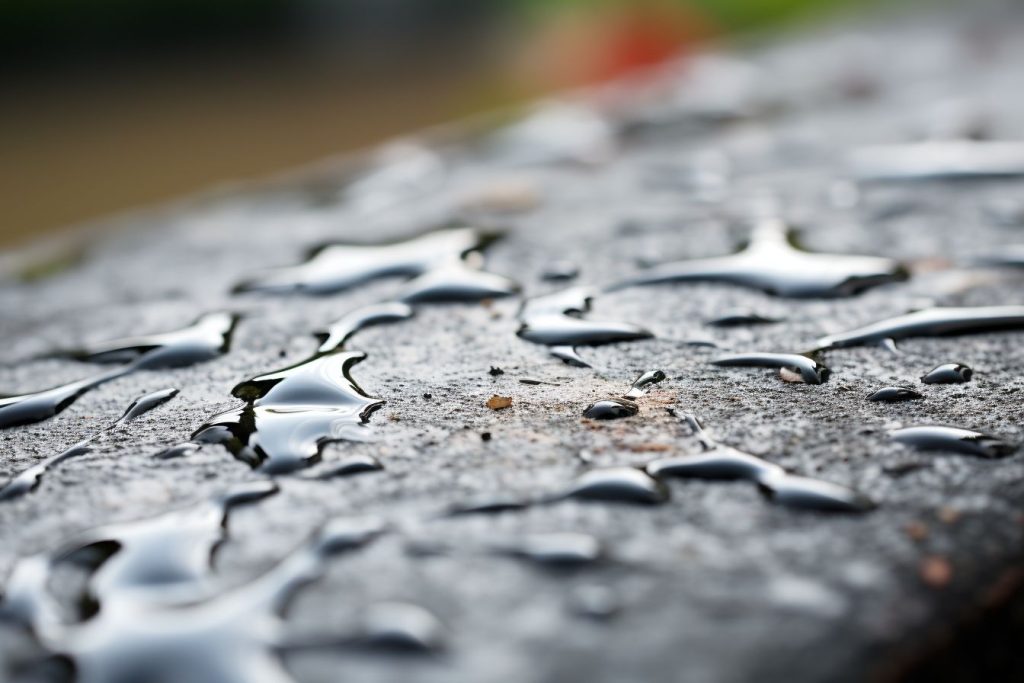Ever noticed water seeping through your flat roof, leaving baffling puddles in unwelcome places? The fact is leaky roofs are a common problem for many homeowners with flat roofing systems.
This blog post aims to shed light on the various causes of these frustrating roof leaks and offer preventive measures to nip them in the bud. So, don’t let that drip drop worry you anymore; read on!
Key Takeaways
- Damaged roofing membranes, open or damaged flashing, blisters or bridging in the roof membrane, skylights, debris accumulation, and ponding water can all cause roof leaks in flat roofs.
- Regular inspections and maintenance by a professional roofer are crucial to preventing roof leaks and addressing issues promptly.
- Promptly addressing issues such as damaged flashing or ponding water can prevent further damage and costly repairs.
Potential Causes of Roof Leaks in Flat Roofs
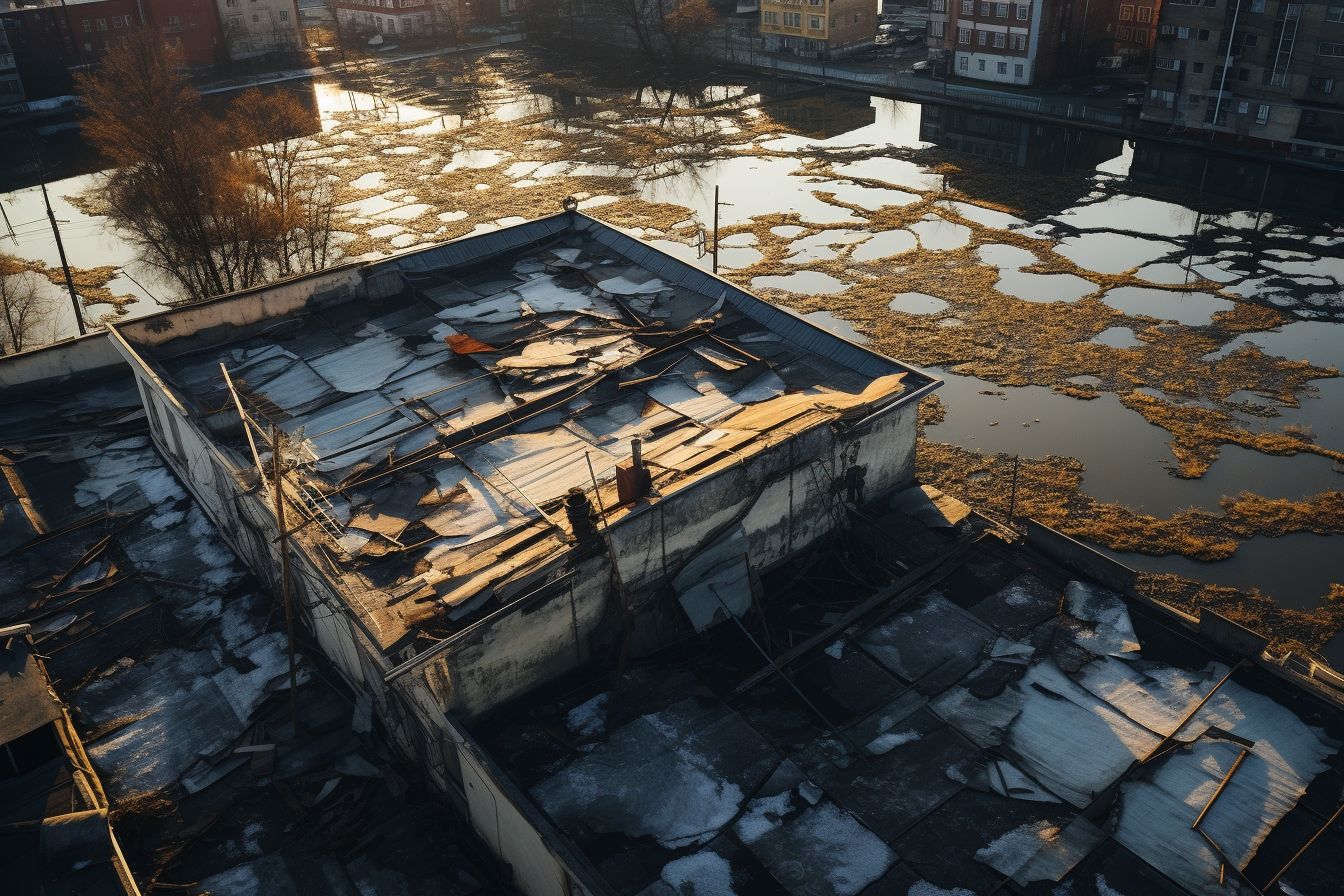
Roof leaks in flat roofs can be caused by damaged roofing membranes, open or damaged flashing, blisters or bridging in the roof membrane, skylights, debris accumulation, and ponding water.
Damaged roofing membranes
Cracks or punctures in the roofing membrane often result in severe leaks on flat roofs. This damage typically occurs due to excessive foot traffic, heavy equipment, or sharp debris.
The air pockets under these damaged membranes can intensify the leakage problem. Especially at risk are flat roofs with wooden decks or external thermal insulation – any leak has the potential to harm these materials severely, escalating repair costs considerably.
Edge areas of flat roofs can be particularly susceptible to leaks due to weather exposure and membrane damage. Regularly checking for signs of wear and tear and promptly addressing them is vital for maintaining a resilient roof cover over your property.
Open or damaged flashing
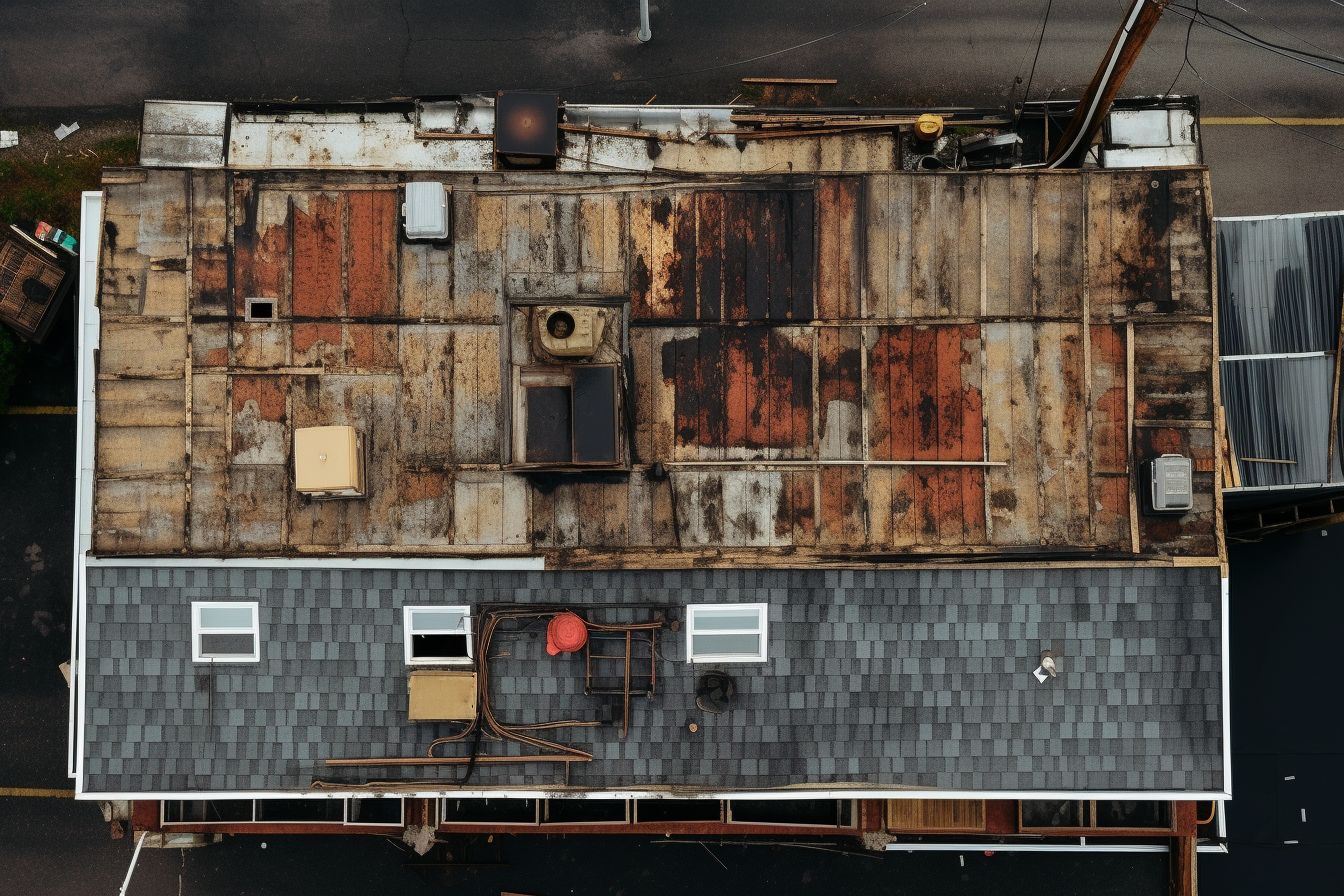
Flashing, an essential component of flat roofs, acts as a barrier at the intersection between the roof surface and any vertical surfaces. It channels water away from these vulnerable areas to prevent leaks.
Open or damaged flashing poses a significant problem for flat or commercial roofs. Crack development in this protective layer often leads to serious roofing problems.
Roofing leaks caused by open or damaged flashing can quickly escalate if left unattended. Water seeping into the cracks can increase in volume during winter when it freezes and thaws repeatedly, widening these fissures even further.
This process accelerates roof damage, possibly leading to severe water damage inside buildings if not addressed promptly. Therefore, regular maintenance and instant repair of damaged flashing are crucial in preventing such roofing issues.
Blisters or bridging in the roof membrane
Blisters or bridging in the roof membrane can cause significant damage to flat roofs. These blisters are caused by pockets of air or moisture trapped under the roofing material, leading to bubbles forming and expanding.
Over time, thermal expansion cycles make these blisters grow larger, which may result in cracks or splits in your roof membrane. This wear and tear could lead to water leaks in the building below.
A poorly installed flat roof is more susceptible to blistering since improper adhesion between materials could create an environment conducive to blister formation. It’s also crucial to promptly address saturated insulation due to blistering, as it significantly accelerates roof decay.
Regular maintenance can detect early signs of blistering and ensure necessary repairs are done promptly, preventing severe structural damage.
Skylights
Skylights are a potential cause of roof leaks in flat roofs. If the flashing connection around the skylight deteriorates, it can lead to water seeping into the roof and causing leakage.
Poorly installed skylights can also result in water leaks, so it’s essential to ensure proper installation by professionals. Additionally, lower-quality skylights can cause damage from UV rays on furniture and flooring and create glare that affects the comfort of your living space.
To prevent these issues, applying a layer of sheet waterproofing over skylights can help keep water out and protect against leaks while enjoying natural light indoors.
Debris accumulation
Debris accumulation is a common problem contributing to roof leaks in flat roofs. When leaves, branches, and other debris build up on the roof, they can block drainage routes and prevent water from properly flowing off the surface.
This leads to water accumulation and increases the risk of leaks. Additionally, the accumulated debris can degrade roofing materials over time and stress the roof structure, further contributing to potential leaks.
Flat roofs with poor drainage or uneven slopes are susceptible to debris buildup and subsequent leaks. Ponding water caused by inadequate design or lack of proper drainage also poses a risk for leaks and water damage on flat roofs.
Ponding water
Ponding water on a flat roof can cause significant problems, including leaks and damage. If not correctly addressed, ponding water can lead to mould growth and structural issues. When the depth of the ponding water exceeds the height of the flashing, it can result in roof leaks.
Additionally, persistent ponding water increases the load on the roof, potentially causing structural deformation. Over time, this standing water can wear down the roofing membrane.
Ultimately, ponding water is one of the most common reasons for leak problems on flat roofs. It is crucial to address this issue promptly to prevent further damage and potentially costly repairs.
Homeowner’s Manual: Handling Roof Leaks

To avoid costly water damage, homeowners must prevent and address roof leaks. Here are some essential steps to follow in a homeowner’s manual when dealing with roof leaks:
- Regularly inspect your roof for any signs of damage, such as cracked or missing tiles, blistering membranes, or damaged flashing.
- If you notice any leaks, locate the source by checking for water stains or wet spots on the ceiling and tracing them back to the roof.
- Once you’ve identified the area of the leak, temporarily fix it using roofing cement or a patch kit specifically designed for your roofing material.
- Contact a professional roofer to assess and repair the leak permanently. They have the expertise and tools to fix the problem effectively.
- Don’t forget to address any underlying issues that may have caused the leak, such as ponding water or debris accumulation on your roof.
- Consider waterproofing your flat roof to add an extra layer of protection against future leaks.
- Finally, remember that regular inspections and maintenance are crucial to preventing roof leaks, so schedule routine check-ups with a professional roofer.
Importance of Routine Maintenance and Repairs
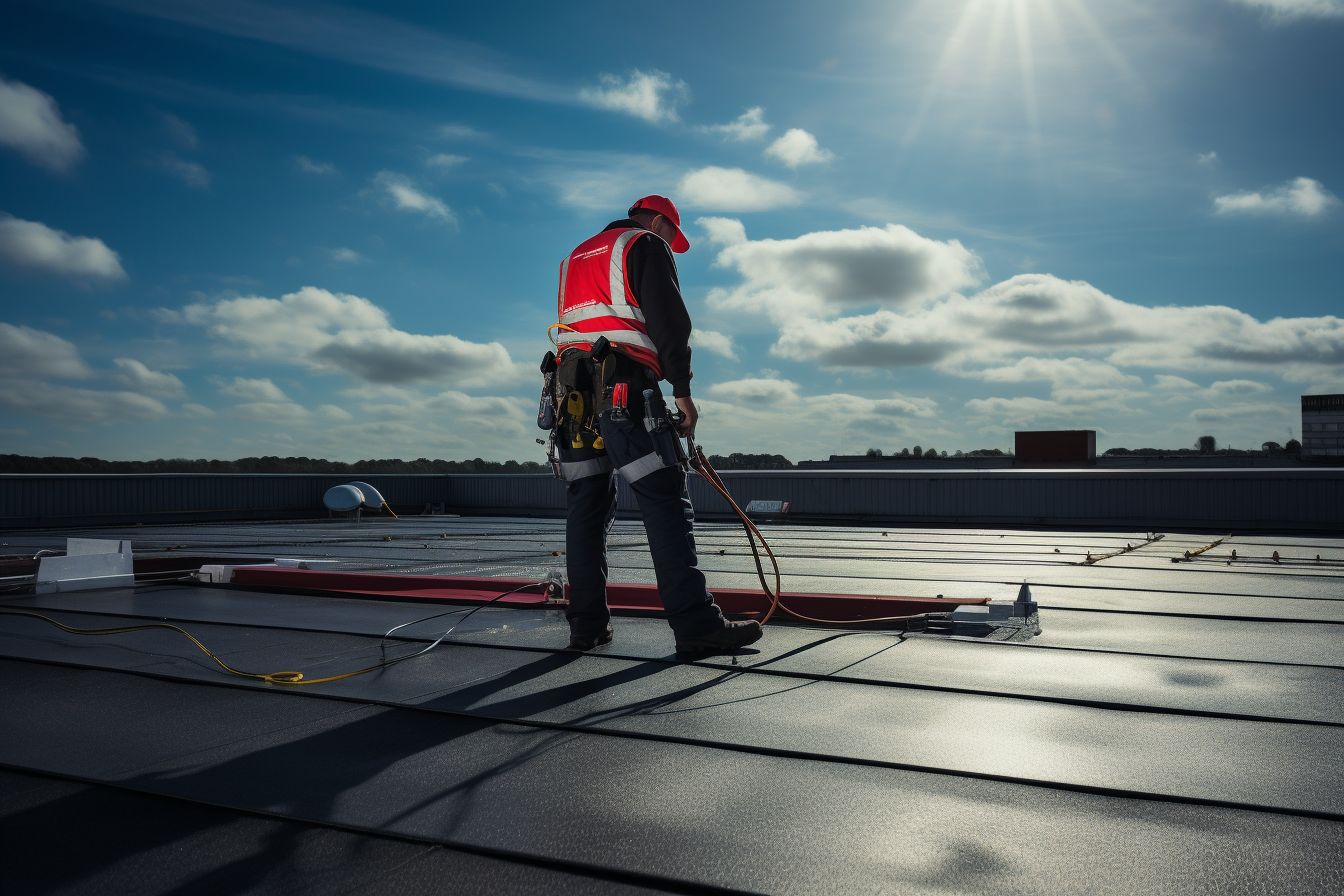
Regular inspections and maintenance by a professional roofer are crucial in preventing roof leaks and addressing any issues promptly. Don’t overlook the significance of taking care of your flat roof to avoid costly repairs.
Read on to learn more about how routine maintenance can help maintain the integrity of your flat roof.
Working with a professional roofer
Hiring a professional roofer is crucial when it comes to maintaining the structural integrity of your roof. A roofing contractor has the expertise and experience to handle roof repairs or maintenance tasks efficiently.
Regular inspections and maintenance carried out by a professional can help identify potential issues before they become major problems, saving you from costly repairs down the line.
When experiencing roof leaks or other damage, it’s important to act promptly and seek professional help. By addressing these issues quickly, you can prevent further water damage and ensure the longevity of your roof.
Regular inspections and maintenance
Regular inspections and maintenance are essential for preventing roof leaks in flat roofs. This proactive approach helps homeowners identify and address issues before they escalate into major problems. Regular inspections allow homeowners to catch potential leaks early on and take appropriate measures to fix them promptly. Additionally, routine maintenance ensures the roof remains in good condition, prolonging its lifespan and saving money on costly repairs or replacement. Homeowners should consider working with a professional roofer with the expertise to conduct thorough inspections and perform necessary repairs efficiently. Regular inspections and maintenance help prevent roof leaks, extend the life of a flat roof, and provide cost-effective maintenance solutions.
Addressing issues promptly
Addressing issues promptly is crucial when it comes to maintaining flat roofs. You can prevent further water damage, mould growth, and structural problems by taking immediate action.
Regular inspections and maintenance allow you to identify any issues early on so that timely repairs can be made. This not only helps prevent costly damage but also ensures the long-term integrity of your roof.
Prompt attention to roof leaks and other roofing issues is key to avoiding more significant problems. So stay on top of your maintenance schedule and promptly address any issues for a leak-free and durable flat roof.
Conclusion
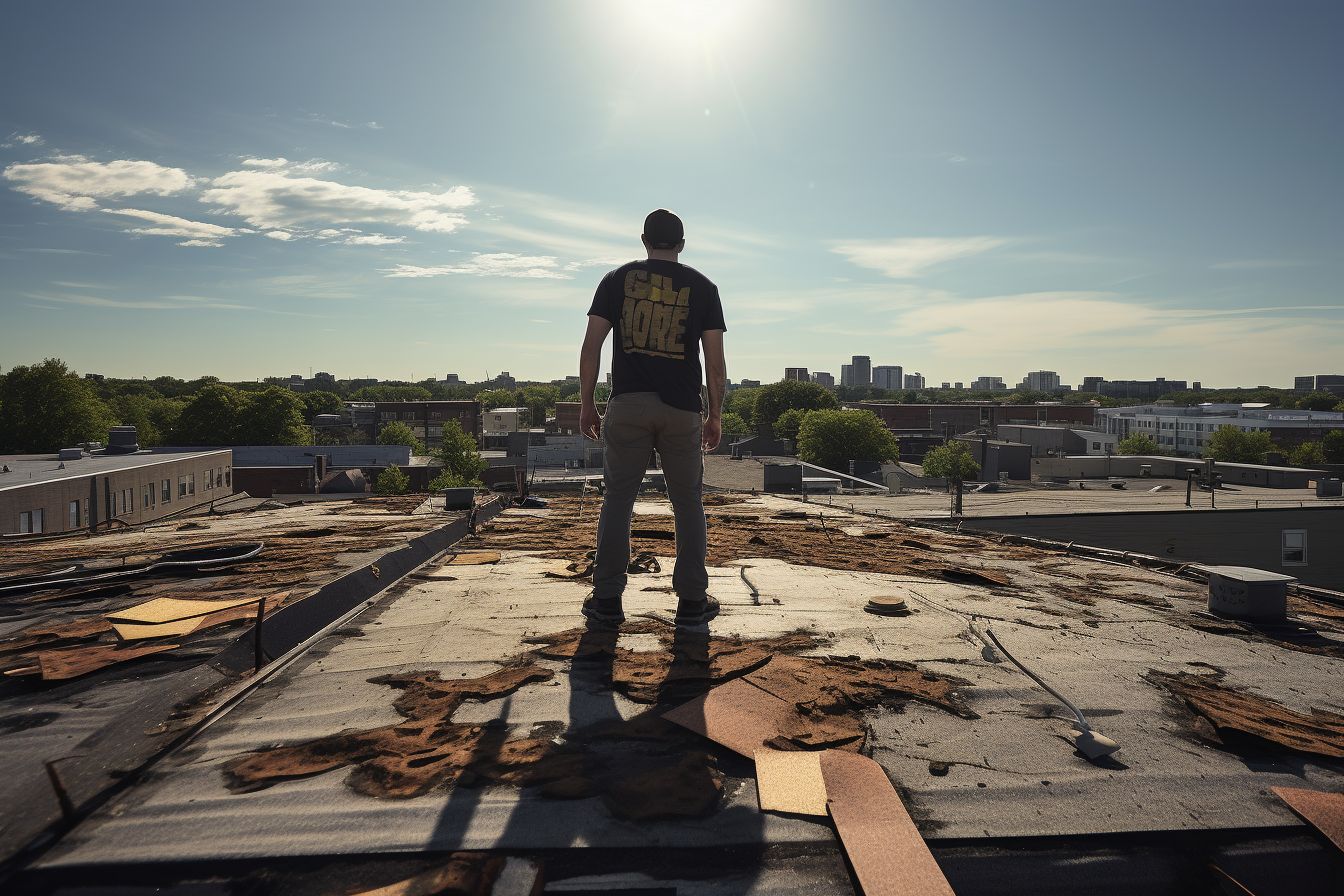
In conclusion, there are several potential causes of roof leaks in flat roofs. Damaged roofing membranes, open or damaged flashing, blisters or bridging in the roof membrane, skylights, and debris accumulation can all contribute to leaks.
Homeowners need to address these issues promptly and work with a professional roofer for regular inspections and maintenance to prevent further damage.
FAQs
1. What are some common causes of roof leaks in flat roofs?
Common causes of roof leaks in flat roofs include damaged or deteriorated roofing materials, clogged or improperly installed drainage systems, and poor installation or maintenance.
2. How can I prevent roof leaks in my flat roof?
To prevent roof leaks in your flat roof, it is essential to regularly inspect and maintain the roofing system, clear any debris from drains and gutters, address any damage promptly, and ensure proper waterproofing.
3. Can extreme weather conditions cause a roof leak in a flat roof?
Yes, extreme weather conditions such as heavy rainstorms or snow accumulation can put extra stress on a flat roof and increase the risk of leaks if the roofing system is not properly designed or maintained.
4. Can I repair a small leak in a flat roof myself?
While minor repairs may be possible for experienced homeowners, consulting with a professional roofing contractor is always recommended for proper assessment and repair of any leaks in your flat roof.
5. How long does it take to fix a leaking problem on a flat roof
The time required to fix a leaking problem on a flat roof depends on various factors, including the extent of damage, accessibility for repairs, and availability of materials. It’s best to consult with professionals for an accurate timeframe based on your situation.

